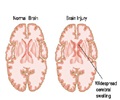A group of regions has been discovered in the human brain that are specifically used for social cognition over the last 10 years. These regions provide insights into how man interacts with his counterparts on a social scale.
A new study in the July/August 2009 issue of the journal Child Development investigates these brain regions for the first time in human children. The study has implications for children with autism.Researchers at Massachusetts Institute of Technology (MIT) and Yale University scanned the brains of 13 children ages 6 to 11 as they listened to children's stories. At the moment the plot of the stories revealed what a character wanted, believed, or knew, or presented the mental state of the character, the researchers observed increased activity in these specific brain regions. When the story turned to other topics—such as the physical world or the visual appearance of the characters—activity in these brain regions went back down.
On the whole, activity in the "social brain" of the children—the parts of their brains that are used for social cognition—looked very similar to the patterns previously observed in adults. But there was one intriguing difference: One of the brain regions, the right tempero-parietal junction, appeared to change its function between the ages of 6 and 11. At age 6, the brain region played a general role in thinking about people, but by age 11, this same brain region appeared to take on a more specialized role in thinking just about others' thoughts.
"What we found—a pattern of typical development—may offer clues as we study atypical social development, as happens in autism," according to Rebecca Saxe, the Fred and Carole Middleton Career Development Professor of cognitive neuroscience at MIT, who led the study.
"Children with autism appear to have specific difficulties thinking about other people's thoughts. Understanding how human brains typically learn to think about thoughts may let us detect what is going wrong in an autistic brain, and maybe even target interventions toward those neural systems, to improve chances for recovery."
Advertisement
RAS














